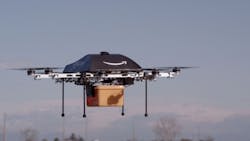There has been a lot of noise recently about drones, mainly since they have been witnessed flying by the White House, Eiffel tower and other strategic places; there is a very nice video(s) of New York City that has been taken by several drones. Due to recent terrorist attacks, people rightfully consider drones a threat or “SFDO”, or Seen Flying Dangerous Objects.
Before those sad events, the main discussion was about Amazon planning to use drones to deliver packages and the drone that was seeing flying near JFK.
Efforts have been made in the past and are still exerted to protect the electric grid, whether by ensuring reliable generation, transmission and distribution system as well as cyber security. Relay protection is another key group that is responsible for selectively isolating faults when they occur while maintaining continuity of service. No matter how hard relay engineers plan to prevent failures, all it takes is for a balloon to trip a transmission or distribution line; so much damage and loss of revenue is caused by a balloon that costs few cents, if any, and is usually a source of happiness for kids but definitely not for the utility.
Unlike balloons that fly freely with no specific direction, intention or hidden agenda, drones are remotely controlled and could do a lot more damage than unguided balloons. Not only can drones cause damage by shorting phases of feeders and substation buses, drones have eyes (cameras) that can cause specific planned damage.
In my opinion drones should only be allowed in certain areas, i.e. parks, specified open space, beaches, etc., definitely not close to any electric assets and since utilities cannot openly send the 7 billion humans a list of all of our substations and transmission routes for them to avoid, we should confine drones in specific locations only.
Even if the drone owner has no bad intention, what happens if he/she accidentally makes contact with an electrical asset or lose power or communication to the drone, thus resulting in the drone falling on top of an electric station or line, thus causing a fault or damage to personnel; or the amazon drone hitting the distribution pole just outside the customer’s house accidentally or due to high winds in the area.
You may argue that Google earth or other available electronic maps represent a threat, which I partially agree with; however, the drone threat far outweighs an electronic map or a balloon. Although drone users and manufactures don’t have evil intention or the plan to shutdown parts of the electric grid, we have to plan for those who do have evil intentions and are willing to use such technologies for the wrong cause.
About the Author
Ahmed Mousa
Principal Engineer/Adjunct Professor/Board Member/Founder & CEO
Ahmed Mousa, M.S.E.E., has over 12 years of experience in transmission, sub-transmission, substations and distribution systems with industry leaders such as Consolidated Edison, PSE&G, PEPCO, and First Energy. He is a subject matter expert in transmission/sub-transmission, distribution and substation planning. Ahmed has years of expertise conducting PSS/E load flows, i.e. forced & scheduled outages analysis, phase angle studies, voltage analysis, network/non-network load transfers. Ahmed provides analysis and support during heat waves, storms and other system emergencies.
Mr. Mousa is an Adjunct Professor at New Jersey Institute of Technology (NJIT) teaching advanced topics graduate electrical engineering courses.
Mr. Mousa serves on the New Jersey Association of Energy Engineers board as a board member.
Mr. Mousa is currently the Principal Engineer at PSE&G in the Electric Delivery Planning section, where he is responsible for managing power system generation, transmission and distribution simulation studies, developing the short/ long range substation forecasts, analysis and load relief, performing short circuit studies, performing breaker duty analysis, developing transmission and distribution station and feeder designs, reviewing large customer demand proposals. Mr. Mousa is responsible for all Distributed Energy Resources technical evaluations and interconnection agreements.
Mr. Mousa is the Founder/CEO of The Electric Bridge Consulting firm assisting large and small utilities, colleges/universities & consulting firms by providing electric utility services, educational/training services, consulting services, leadership seminars, career consulting, lecturing services, electric professional engineering courses & national & international webinars.
Mr. Mousa was responsible for the short term, long term (1/5/10/20/30 years), and emergency planning for the area substation, transmission / sub-transmission feeders and the 4 kV system at Consolidated Edison. He has conducted several studies on the impact of electric vehicles, distributed generation, steam to AC conversion, energy efficiency models, and R&D initiatives on the distribution and transmission system.
Mr. Mousa was the project manager for a SCADA GE XA21 Energy Management System and the project manager and project engineer for President Obama’s Department of Energy stimulus grant for Consolidated Edison’s 4 kV system.
Awards include the 2009 3rd Quarter Distribution Engineering ALVA Award for 21st Century Leader, the 2012 “Sustain Energy Reliability” Team Award, and the 2013 Excellence in Design and Genius Engineer (EDGE) Award Nominee for “Developed Load Calculation Tools for System and Transmission Operations.” He has over eight years of experience in providing training in a wide range of subjects including PSS/E, 4 kV systems, distributed generation grid adoption, system operation outage analysis, transformer ratings, voltage studies, basic and advanced power flow, intermeshes, phase angle studies, capacitor bank impact on the grid, smart grid, plant information (PI), post contingency analysis, voltage reduction, and conservation voltage optimization. Mr. Mousa received his Bachelor's Degree in Electrical Engineering from Stony Brook University and later a Master's Degree in Electrical Engineering from Manhattan College and has completed the Siemens PTI Distribution and Transmission courses.
